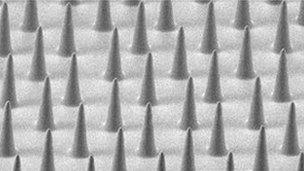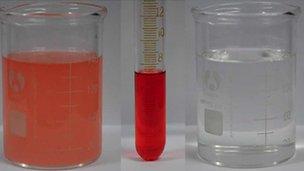Cactus-inspired material cleans oily water
- Published

Oil spills may be cleaned using a method inspired by cactus needles
Arrays of tiny copper spikes can clean oil from water, mimicking the way cacti pull water out of desert air.
Chinese researchers had noticed that cone-shaped cactus spines harvest water from air pushing it to their base.
Copying Nature's design, they used conical copper needles to separate tiny oil drops from dirty water - a problem existing methods struggle with.
The scientists, who are based in Beijing, have reported their results in the journal Nature Communications, external.
The discovery points the way to a new method for addressing environmental problems like oil spill clean up, with the artificial spines capturing microscopic droplets of oil underwater, continuously transporting them to the base of the sheet of spikes.
Last year, researchers from Beijing reported the discovery that the conical needles of the "bunny ear" cactus, Optunia microdasys, can collect water from the air.
Droplets of water coalesce on its barbed spines and are then driven to the spine base by the interaction between the shape of the spine and the surface tension of the water droplet.
They now report that synthetic spines are capable of separating and collecting oil droplets out of water in just the same way, and have made a synthetic "cactus skin" of needles that do exactly that.
While oil and water don't mix, if very small droplets of oil co-mingle with water it becomes almost impossible to separate the droplets out of the water again - an example is homogenised milk, in which tiny fat droplets stay suspended in the milk forever.
Describing their method, Lei Jiang, leader of the research project, said: "We fabricated needle arrays. Each conical needle in the array is a little oil collection device. The arrays can collect micron-sized oil droplets from water continuously and effectively."
Microscopic bed of nails
The synthetic needles are half a millimetre long, and will remove tiny micron-sized droplets of oil from water, which are very difficult to separate out by any other method. In tests they found that hexagonal arrays of these needles could separate around 99% of oil mixed with water.

Arrays of needles 0.5 mm tall can harvest oil from water
The researchers have constructed conical needles made of copper and of a silicone polymer and find that the affinity of the material surface for oil, together with the shape of the cone are crucial in the operation of the device, but that rougher cones are more efficient at harvesting oil from water.
"This excellent piece of work provides a perfect example of first describing an interesting biological system and then taking it one step further by solving an engineering problem." Professor Joanna Aizenberg of Harvard University told the BBC. "It shows not only how we can learn from Nature but also how to apply that knowledge in bio-inspired design.
"It is a beautiful experiment, and seems very effective showing almost complete separation of oil and water. Next, it will require scaling up and testing in field experiments."
The phenomenon relies on the fact that the radius of a cone surface is very small near the tip, and larger further from the tip towards the base. This causes a pressure difference for a droplet at the tip compared to near the base forcing the liquid to move to the wider part of the cone. As a droplet moves along it captures any others on the way, coalescing at the cone's base.
Different types of oil-water mixtures were tested, including vegetable oil, gasoline, and organic solvents mixed with water, and all were successfully separated in the same process.

Structured surfaces can separate mixtures (left) to near pure oil (centre) and water (right)
Copying designs from Nature, or biomimicry, is a growing area of materials technology, and such materials are termed biomimetic.
Professor Stephen Michielsen from North Carolina State University spoke to the BBC and said of the Beijing group: "Their main research area is trying to mimic Nature. In the past they have looked at spiders' webs and at cacti, and now they are using the same concepts to gather tiny tiny oil droplets from water.
"Their method should also work to remove really tiny oil drops from air, which occur when oil gets aerosolised in compressed air. This should be a more efficient method than filters.
"They are very good at observing what Nature does and mimicking it - Nature has perfected methods over the years and this group has done a great job at figuring out how to put it all together."
Previous examples of biomimetic inventions include Velcro fasteners (copying plant burrs that get stuck onto animal fur), the friction-reducing sharkskin swimsuits used at the Beijing Olympics, and artificial photosynthesis employed by some of the latest solar cells.
- Published23 November 2012
- Published8 November 2012
- Published30 August 2012
- Published28 October 2011
- Published8 July 2013